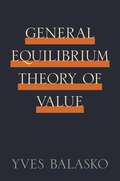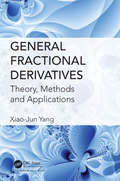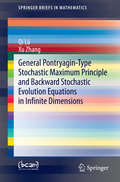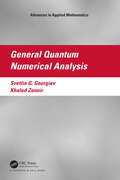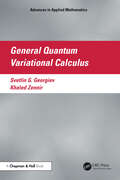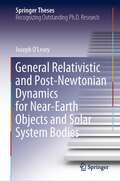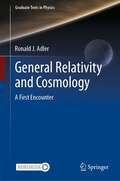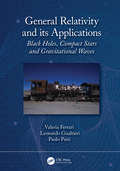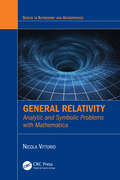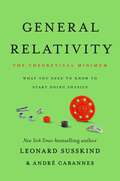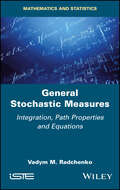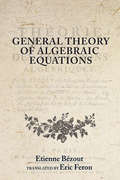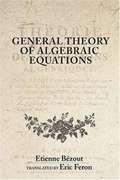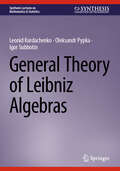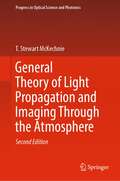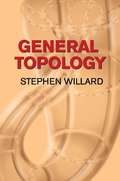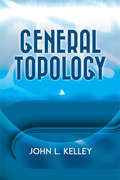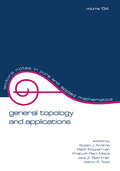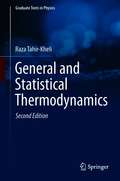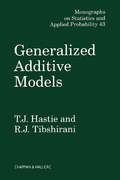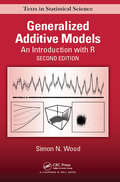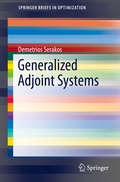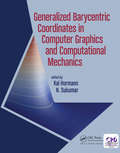- Table View
- List View
General Equilibrium Theory of Value
by Yves BalaskoThe concept of general equilibrium, one of the central components of economic theory, explains the behavior of supply, demand, and prices by showing that supply and demand exist in balance through pricing mechanisms. The mathematical tools and properties for this theory have developed over time to accommodate and incorporate developments in economic theory, from multiple markets and economic agents to theories of production. Yves Balasko offers an extensive, up-to-date look at the standard theory of general equilibrium, to which he has been a major contributor. This book explains how the equilibrium manifold approach can be usefully applied to the general equilibrium model, from basic consumer theory and exchange economies to models with private ownership of production. Balasko examines properties of the standard general equilibrium model that are beyond traditional existence and optimality. He applies the theory of smooth manifolds and mappings to the multiplicity of equilibrium solutions and related discontinuities of market prices. The economic concepts and differential topology methods presented in this book are accessible, clear, and relevant, and no prior knowledge of economic theory is necessary. General Equilibrium Theory of Value offers a comprehensive foundation for the most current models of economic theory and is ideally suited for graduate economics students, advanced undergraduates in mathematics, and researchers in the field.
General Fractional Derivatives: Theory, Methods and Applications
by Xiao-Jun YangGeneral Fractional Derivatives: Theory, Methods and Applications provides knowledge of the special functions with respect to another function, and the integro-differential operators where the integrals are of the convolution type and exist the singular, weakly singular and nonsingular kernels, which exhibit the fractional derivatives, fractional integrals, general fractional derivatives, and general fractional integrals of the constant and variable order without and with respect to another function due to the appearance of the power-law and complex herbivores to figure out the modern developments in theoretical and applied science. Features: Give some new results for fractional calculus of constant and variable orders. Discuss some new definitions for fractional calculus with respect to another function. Provide definitions for general fractional calculus of constant and variable orders. Report new results of general fractional calculus with respect to another function. Propose news special functions with respect to another function and their applications. Present new models for the anomalous relaxation and rheological behaviors. This book serves as a reference book and textbook for scientists and engineers in the fields of mathematics, physics, chemistry and engineering, senior undergraduate and graduate students. Dr. Xiao-Jun Yang is a full professor of Applied Mathematics and Mechanics, at China University of Mining and Technology, China. He is currently an editor of several scientific journals, such as Fractals, Applied Numerical Mathematics, Mathematical Modelling and Analysis, International Journal of Numerical Methods for Heat & Fluid Flow, and Thermal Science.
General Investigations of Curved Surfaces: Edited with an Introduction and Notes by Peter Pesic
by Peter Pesic Adam Hiltebeitel James Morehead Karl Friedrich GaussGauss's theory of surfaces is among the purely mathematical achievements inspired by ideas that arose in connection with surveys of the surface of the earth. Long regarded as a masterpiece in content and form, this work features one of the author's most original contributions to mathematics--the discovery that Gauss termed the "Theorema Egregium." It consists of his penetrating definition of the concept of surface curvature and the theorem that the "Gauss curvature" is invariant under arbitrary isometric deformation of a curved surface. The profound effects of these concepts were soon generalized by Bernhard Riemann, and subsequent development included the important role of the Gauss-Riemann concept of curvature in modern relativity theory.This edition of Gauss's classic work features a new introduction, bibliography, and notes by science historian Peter Pesic. In addition, an informative appendix offers historical background.
General Pontryagin-Type Stochastic Maximum Principle and Backward Stochastic Evolution Equations in Infinite Dimensions
by Qi Lü Xu ZhangThe classical Pontryagin maximum principle (addressed to deterministic finite dimensional control systems) is one of the three milestones in modern control theory. The corresponding theory is by now well-developed in the deterministic infinite dimensional setting and for the stochastic differential equations. However, very little is known about the same problem but for controlled stochastic (infinite dimensional) evolution equations when the diffusion term contains the control variables and the control domains are allowed to be non-convex. Indeed, it is one of the longstanding unsolved problems in stochastic control theory to establish the Pontryagin type maximum principle for this kind of general control systems: this book aims to give a solution to this problem. This book will be useful for both beginners and experts who are interested in optimal control theory for stochastic evolution equations.
General Quantum Numerical Analysis (ISSN)
by Svetlin G. Georgiev Khaled ZennirThis book is focused on the qualitative theory of general quantum calculus, the modern name for the investigation of calculus without limits. It centers on designing, analysing and applying computational techniques for general quantum differential equations. The quantum calculus or q-calculus began with F.H. Jackson in the early twentieth century, but this kind of calculus had already been worked out by Euler and Jacobi. Recently, it has aroused interest due to high demand of mathematics that models quantum computing and the connection between mathematics and physics.Quantum calculus has many applications in different mathematical areas such as number theory, combinatorics, orthogonal polynomials, basic hyper-geometric functions and other sciences such as quantum theory, mechanics and the theory of relativity.The authors summarize the most recent contributions in this area. General Quantum Numerical Analysis is intended for senior undergraduate students and beginning graduate students of engineering and science courses. The twelve chapters in this book are pedagogically organized, each concluding with a section of practical problems.
General Quantum Variational Calculus (Advances in Applied Mathematics)
by Svetlin G. Georgiev Khaled ZennirQuantum calculus is the modern name for the investigation of calculus without limits. Quantum calculus, or q-calculus, began with F.H. Jackson in the early twentieth century, but this kind of calculus had already been worked out by renowned mathematicians Euler and Jacobi.Lately, quantum calculus has aroused a great amount of interest due to the high demand of mathematics that model quantum computing. The q-calculus appeared as a connection between mathematics and physics. It has a lot of applications in different mathematical areas such as number theory, combinatorics, orthogonal polynomials, basic hypergeometric functions and other quantum theory sciences, mechanics, and the theory of relativity. Recently, the concept of general quantum difference operators that generalize quantum calculus has been defined. General Quantum Variational Calculus is specially designed for those who wish to understand this important mathematical concept, as the text encompasses recent developments of general quantum variational calculus. The material is presented in a highly readable, mathematically solid format. Many practical problems are illustrated, displaying a wide variety of solution techniques.This book is addressed to a wide audience of specialists such as mathematicians, physicists, engineers, and biologists. It can be used as a textbook at the graduate level and as a reference for several disciplines.
General Relativistic and Post-Newtonian Dynamics for Near-Earth Objects and Solar System Bodies (Springer Theses)
by Joseph O’LearyOwing to the increased accuracy requirements in fields such as astrometry and geodesy the general theory of relativity must be taken into account for any mission requiring highly accurate orbit information and for practically all observation and measurement techniques. This book highlights the confluence of Applied Mathematics, Physics and Space Science as seen from Einstein's general theory of relativity and aims to bridge the gap between theoretical and applied domains. The book investigates three distinct areas of general relativity: Exact solutions of the Einstein field equations of gravitation. Dynamics of near-Earth objects and solar system bodies. Relativistic orbitography. This book is an updated and expanded version of the author’s PhD thesis which was awarded the International Astronomical Union PhD prize in Division A: Fundamental Astronomy. Included is a new introduction aimed at graduate students of General Relativity and extended discussions and results on topics in post-Newtonian dynamics and general relativistic spacecraft propagation.
General Relativity Without Calculus
by Jose Natario"General Relativity Without Calculus" offers a compact but mathematically correct introduction to the general theory of relativity, assuming only a basic knowledge of high school mathematics and physics. Targeted at first year undergraduates (and advanced high school students) who wish to learn Einstein's theory beyond popular science accounts, it covers the basics of special relativity, Minkowski space-time, non-Euclidean geometry, Newtonian gravity, the Schwarzschild solution, black holes and cosmology. The quick-paced style is balanced by over 75 exercises (including full solutions), allowing readers to test and consolidate their understanding.
General Relativity and Cosmology: A First Encounter (Graduate Texts in Physics)
by Ronald J. AdlerGravitational physics has now become a mainstream topic in physics and physics teaching. In particular cosmology and gravitational wave physics are at the focus of a great deal of current research. Thus it is important to introduce students to General Relativity as soon as reasonable. This textbook offers a brief but comprehensive treatment accessible to advanced undergraduate students, graduate students, and any physicist or mathematician interested in understanding the material in a short time. The author, an experienced teacher of the subject, has included numerous examples and exercises to help students consolidate the ideas they have learned.
General Relativity and its Applications: Black Holes, Compact Stars and Gravitational Waves
by Paolo Pani Valeria Ferrari Leonardo GualtieriContaining the latest, groundbreaking discoveries in the field, this text outlines the basics of Einstein’s theory of gravity with a focus on its most important astrophysical consequences, including stellar structures, black holes and the physics of gravitational waves. Blending advanced topics - usually not found in introductory textbooks - with examples, pedagogical boxes, mathematical tools and practical applications of the theory, this textbook maximises learning opportunities and is ideal for master and graduate students in Physics and Astronomy. Key features:• Provides a self-contained and consistent treatment of the subject that does not require advanced previous knowledge of the field.• Explores the subject with a new focus on gravitational waves and astrophysical relativity, unlike current introductory textbooks.• Fully up-to-date, containing the latest developments and discoveries in the field.
General Relativity: Analytic and Symbolic Problems with Mathematica (Series in Astronomy and Astrophysics)
by Nicola VittorioThis book provides General Relativity problems to be tackled both analytically and symbolically-numerically with the Mathematica software. In the first case, the reader is guided in setting up the appropriate solutions. In the second case, the reader is provided with very illustrative notebooks to carry out the steps necessary to solve a General Relativity problem. These include the calculation of the Christoffel symbols, Riemann, Ricci, Einstein and energy-momentum tensors, as well as the resolution of the field equations of General Relativity in different astrophysical/cosmological contexts, with and without the introduction of a cosmological constant. This study guide should be used alongside existing textbooks to provide additional learning and engagement opportunities for advanced undergraduate and graduate students in physics and astrophysics taking courses on general relativity. It may also be of interest to mathematics students interested in celestial mechanics and space sciences.A number of the Mathematica codes used in this book can be accessed online here; [INSERT URL WHEN AVAILABLE]Key Features:• Promotes the "learning by doing" approach, guiding the student in the building of the mathematical apparatus necessary to solve problems in General Relativity.• Encourages the development of analytical skills to address and solve specific and challenging problems in General Relativity.• Develops symbolic-numerical skills to address problems (often already solved analytically) so that the reader is prepared to attack even more elaborate calculations in General Relativity.
General Relativity: The Theoretical Minimum (The Theoretical Minimum)
by Leonard Susskind André CabannesThe latest volume in the New York Times–bestselling physics series explains Einstein&’s masterpiece: the general theory of relativity He taught us classical mechanics, quantum mechanics, and special relativity. Now, physicist Leonard Susskind, assisted by a new collaborator, André Cabannes, returns to tackle Einstein&’s general theory of relativity. Starting from the equivalence principle and covering the necessary mathematics of Riemannian spaces and tensor calculus, Susskind and Cabannes explain the link between gravity and geometry. They delve into black holes, establish Einstein field equations, and solve them to describe gravity waves. The authors provide vivid explanations that, to borrow a phrase from Einstein himself, are as simple as possible (but no simpler). An approachable yet rigorous introduction to one of the most important topics in physics, General Relativity is a must-read for anyone who wants a deeper knowledge of the universe&’s real structure.
General Stochastic Measures: Integration, Path Properties and Equations
by Vadym M. RadchenkoThis book is devoted to the study of stochastic measures (SMs). An SM is a sigma-additive in probability random function, defined on a sigma-algebra of sets. SMs can be generated by the increments of random processes from many important classes such as square-integrable martingales and fractional Brownian motion, as well as alpha-stable processes. SMs include many well-known stochastic integrators as partial cases.General Stochastic Measures provides a comprehensive theoretical overview of SMs, including the basic properties of the integrals of real functions with respect to SMs. A number of results concerning the Besov regularity of SMs are presented, along with equations driven by SMs, types of solution approximation and the averaging principle. Integrals in the Hilbert space and symmetric integrals of random functions are also addressed.The results from this book are applicable to a wide range of stochastic processes, making it a useful reference text for researchers and postgraduate or postdoctoral students who specialize in stochastic analysis.
General Theory of Algebraic Equations
by Etienne BézoutThis book provides the first English translation of Bezout's masterpiece, the General Theory of Algebraic Equations. It follows, by almost two hundred years, the English translation of his famous mathematics textbooks. Here, Bézout presents his approach to solving systems of polynomial equations in several variables and in great detail. He introduces the revolutionary notion of the "polynomial multiplier," which greatly simplifies the problem of variable elimination by reducing it to a system of linear equations. The major result presented in this work, now known as "Bézout's theorem," is stated as follows: "The degree of the final equation resulting from an arbitrary number of complete equations containing the same number of unknowns and with arbitrary degrees is equal to the product of the exponents of the degrees of these equations." The book offers large numbers of results and insights about conditions for polynomials to share a common factor, or to share a common root. It also provides a state-of-the-art analysis of the theories of integration and differentiation of functions in the late eighteenth century, as well as one of the first uses of determinants to solve systems of linear equations. Polynomial multiplier methods have become, today, one of the most promising approaches to solving complex systems of polynomial equations or inequalities, and this translation offers a valuable historic perspective on this active research field.
General Theory of Algebraic Equations
by Etienne ÉzoutThis book provides the first English translation of Bezout's masterpiece, the General Theory of Algebraic Equations. It follows, by almost two hundred years, the English translation of his famous mathematics textbooks. Here, Bézout presents his approach to solving systems of polynomial equations in several variables and in great detail. He introduces the revolutionary notion of the "polynomial multiplier," which greatly simplifies the problem of variable elimination by reducing it to a system of linear equations. The major result presented in this work, now known as "Bézout's theorem," is stated as follows: "The degree of the final equation resulting from an arbitrary number of complete equations containing the same number of unknowns and with arbitrary degrees is equal to the product of the exponents of the degrees of these equations." The book offers large numbers of results and insights about conditions for polynomials to share a common factor, or to share a common root. It also provides a state-of-the-art analysis of the theories of integration and differentiation of functions in the late eighteenth century, as well as one of the first uses of determinants to solve systems of linear equations. Polynomial multiplier methods have become, today, one of the most promising approaches to solving complex systems of polynomial equations or inequalities, and this translation offers a valuable historic perspective on this active research field.
General Theory of Leibniz Algebras (Synthesis Lectures on Mathematics & Statistics)
by Leonid Kurdachenko Oleksandr Pypka Igor SubbotinThis book discusses many interesting results have been obtained in Leibniz algebras over the past two decades. The authors not only summarize recent results and methods successfully used in Leibniz algebras, but also show new prospective horizons. Any mathematical theories have a number of natural problems that arise in the process of its development, and these problems quite often have analogues in other areas such as differential geometry, homological algebra, classical algebraic topology, noncommutative geometry, etc. With this in mind the authors describe the general structure of Leibniz algebras that have already been discovered. This approach allows readers to see which parts of the theory should be developed further and also shows the significant differences of Leibniz algebras from Lie algebras. Recent results that constitute the naturally evolving general theory of the subject are then explored.
General Theory of Light Propagation and Imaging Through the Atmosphere (Progress in Optical Science and Photonics #20)
by T. Stewart McKechnieThis 2nd edition lays out an updated version of the general theory of light propagation and imaging through Earth’s turbulent atmosphere initially developed in the late ‘70s and ‘80s, with additional applications in the areas of laser communications and high-energy laser beam propagation. New material includes a chapter providing a comprehensive mathematical tool set for precisely characterizing image formation with the anticipated Extremely Large Telescopes (ELTS), enabling a staggering range of star image shapes and sizes; existing chapters rewritten or modified so as to supplement the mathematics with clearer physical insight through written and graphical means; a history of the development of present-day understanding of light propagation and imaging through the atmosphere as represented by the general theory described. Beginning with the rudimentary, geometrical-optics based understanding of a century ago, it describes advances made in the 1960s, including the development of the ‘Kolmogorov theory,’ the deficiencies of which undermined its credibility, but not before it had done enormous damage, such as construction of a generation of underperforming ‘light bucket’ telescopes. The general theory requires no a priori turbulence assumptions. Instead, it provides means for calculating the turbulence properties directly from readily-measurable properties of star images.
General Topology
by Stephen WillardAmong the best available reference introductions to general topology, this volume is appropriate for advanced undergraduate and beginning graduate students. Its treatment encompasses two broad areas of topology: "continuous topology," represented by sections on convergence, compactness, metrization and complete metric spaces, uniform spaces, and function spaces; and "geometric topology," covered by nine sections on connectivity properties, topological characterization theorems, and homotopy theory. Many standard spaces are introduced in the related problems that accompany each section (340 exercises in all). The text's value as a reference work is enhanced by a collection of historical notes, a bibliography, and index. 1970 edition. 27 figures.
General Topology (Dover Books on Mathematics)
by John L. Kelley"The clarity of the author's thought and the carefulness of his exposition make reading this book a pleasure," noted the Bulletin of the American Mathematical Society upon the 1955 publication of John L. Kelley's General Topology. This comprehensive treatment for beginning graduate-level students immediately found a significant audience, and it remains a highly worthwhile and relevant book for students of topology and for professionals in many areas. A systematic exposition of the part of general topology that has proven useful in several branches of mathematics, this volume is especially intended as background for modern analysis. An extensive preliminary chapter presents mathematical foundations for the main text. Subsequent chapters explore topological spaces, the Moore-Smith convergence, product and quotient spaces, embedding and metrization, and compact, uniform, and function spaces. Each chapter concludes with an abundance of problems, which form integral parts of the discussion as well as reinforcements and counter examples that mark the boundaries of possible theorems. The book concludes with an extensive index that provides supplementary material on elementary set theory.
General Topology and Applications: Fifth Northeast Conference (Annals Of The New York Academy Of Sciences Ser. #Vol. 659)
by Susan J. AndimaThis book is based on the proceedings of the Fifth Northeast Conference on General Topology and Applications, held at The College of Staten Island – The City University of New York. It provides insight into the relationship between general topology and other areas of mathematics.
General and Statistical Thermodynamics (Graduate Texts in Physics)
by Raza Tahir-KheliThis textbook provides comprehensive information on general and statistical thermodynamics. It begins with an introductory statistical mechanics course, deriving all the important formulae meticulously and explicitly, without mathematical shortcuts. In turn, the main part of the book focuses on in-depth discussions of the concepts and laws of thermodynamics, van der Waals, Kelvin and Claudius theories, ideal and real gases, thermodynamic potentials, phonons and all related aspects. To elucidate the concepts introduced and to provide practical problem-solving support, numerous carefully worked-out examples are included. The text is clearly written and punctuated with a number of interesting anecdotes. The book also provides alternative solutions to problems and second equivalent explanations of important physical concepts. This second edition has been expanded to cover the foundations of superconductivity with new chapters on Cooper pairs, the Bogoliubov transformation, and superconductivity. It is suitable as a main thermodynamics textbook for upper-undergraduate students and provides extensive coverage, allowing instructors to ‘pick and choose’ the elements that best match their class profile.
Generalized Additive Models
by T.J. HastieThis book describes an array of power tools for data analysis that are based on nonparametric regression and smoothing techniques. These methods relax the linear assumption of many standard models and allow analysts to uncover structure in the data that might otherwise have been missed. While McCullagh and Nelder's Generalized Linear Models shows how to extend the usual linear methodology to cover analysis of a range of data types, Generalized Additive Models enhances this methodology even further by incorporating the flexibility of nonparametric regression. Clear prose, exercises in each chapter, and case studies enhance this popular text.
Generalized Additive Models: An Introduction with R, Second Edition (Chapman & Hall/CRC Texts in Statistical Science)
by Simon N. WoodThe first edition of this book has established itself as one of the leading references on generalized additive models (GAMs), and the only book on the topic to be introductory in nature with a wealth of practical examples and software implementation. It is self-contained, providing the necessary background in linear models, linear mixed models, and generalized linear models (GLMs), before presenting a balanced treatment of the theory and applications of GAMs and related models. The author bases his approach on a framework of penalized regression splines, and while firmly focused on the practical aspects of GAMs, discussions include fairly full explanations of the theory underlying the methods. Use of R software helps explain the theory and illustrates the practical application of the methodology. Each chapter contains an extensive set of exercises, with solutions in an appendix or in the book’s R data package gamair, to enable use as a course text or for self-study.
Generalized Adjoint Systems
by Demetrios SerakosThis book defines and develops the generalized adjoint of an input-output system. It is the result of a theoretical development and examination of the generalized adjoint concept and the conditions under which systems analysis using adjoints is valid. Results developed in this book are useful aids for the analysis and modeling of physical systems, including the development of guidance and control algorithms and in developing simulations. The generalized adjoint system is defined and is patterned similarly to adjoints of bounded linear transformations. Next the elementary properties of the generalized adjoint system are derived. For a space of input-output systems, a generalized adjoint map from this space of systems to the space of generalized adjoints is defined. Then properties of the generalized adjoint map are derived. Afterward the author demonstrates that the inverse of an input-output system may be represented in terms of the generalized adjoint. The use of generalized adjoints to determine bounds for undesired inputs such as noise and disturbance to an input-output system is presented and methods which parallel adjoints in linear systems theory are utilized. Finally, an illustrative example is presented which utilizes an integral operator representation for the system mapping.
Generalized Barycentric Coordinates in Computer Graphics and Computational Mechanics
by N. Sukumar Kai HormannIn Generalized Barycentric Coordinates in Computer Graphics and Computational Mechanics, eminent computer graphics and computational mechanics researchers provide a state-of-the-art overview of generalized barycentric coordinates. Commonly used in cutting-edge applications such as mesh parametrization, image warping, mesh deformation, and finite as well as boundary element methods, the theory of barycentric coordinates is also fundamental for use in animation and in simulating the deformation of solid continua. Generalized Barycentric Coordinates is divided into three sections, with five chapters each, covering the theoretical background, as well as their use in computer graphics and computational mechanics. A vivid 16-page insert helps illustrating the stunning applications of this fascinating research area. <P><P>Key Features: <li>Provides an overview of the many different types of barycentric coordinates and their properties. <li>Discusses diverse applications of barycentric coordinates in computer graphics and computational mechanics. <li>The first book-length treatment on this topic
